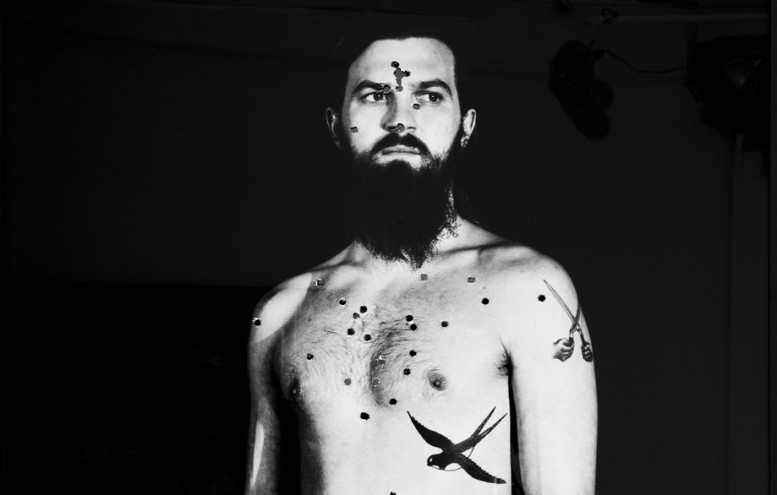You'd think by the look of things that artist Maxwell Snow's outlook on life is decidedly grim, but amidst the decay and the funereal macabre lies a deep curiosity about what it means to really be alive. His artistic oeuvre is a documentation of sorts of life's constant and cruel reminder of its strange impermanence, from the grim-reaperesque portraits of hooded KKK members, to his stark black and white imagery of skulls, crosses, coffins, and girls tied to railway tracks, to a headstone in a recent series that reads, "Wish you were here." However, Snow, who is based in New York City, seems fastidiously intentional about his philosophies on life and death. There is a sense that Snow subscribes to the notion that the soul lives forever and the body is like a some sort of racing motorcycle and we're all blowing down the highway at 120 miles an hour and we might as well crash into the wall at full speed in a heap of burning metal than at a slow meaningless sputter. Snow's new series 100 Headless Women, which will be on view this March at the Kathleen Cullen gallery in New York, explores this notion further by turning the gallery walls into a mausoleum with a selection of ghostly mugshots, black and white photographs of statues of saints who were doused in acid to obscure their features, and a series of portraits of nude women with their faces blackened out with a whip of etching ink in order "[to wrap them] in a cloak of anonymity to seal their singular identities….[so] the viewer is asked to focus on the collection group and devise a story within." I got a chance to ask Maxwell Snow a few questions about death, life, the afterlife, his inspirations, and a run down on what his new show is all about. Read interview after the jump and see selections from the new series.
PAS UN AUTRE: A lot of your work seems to be seeped in the mythologies of death and the afterlife – where do these allusions to death and darkness come from?
MAXWELL SNOW: Death is ever present. Human beings for as long as they have been on this planet, have been fascinated with the afterlife. I would say for good reason. It is a part of almost every story. In mythology, heroes and saints are defined by how they die as much as by how they live, Artistic representations of the end of life stimulate my curiosity. As a child I was always interested in stories of great men and I continue to be inspired by the hero’s journey. Death is a mystery. Einstein said, “The most beautiful thing we can experience is the mysterious.” Death is beautiful. No one likes to talk about it, people want to sanitize the idea of death because they are afraid of it. People fixate on the physical side of it and not the metaphysical. You cannot erase energy you can only change its form. The soul doesn’t die it just takes its clothes off at the end.
AUTRE: What do you expect the afterlife to be like?
SNOW: If its hell its Time Square but I imagine the conversation there will be more interesting than anywhere else.
AUTRE: You started to pop up on the gallery circuit around 2008 - have you always been such a consummate artist?
SNOW: Thank you for that but satisfaction with my work is elusive. There is no such thing as consummation. I am always striving for an imaginary plateau that can never be reached. Always looking for perfection, though impossible, I aim for it. I want to make things that resonate with the universe.
AUTRE: Where does the outlaw persona come from - what is it about the American outlaw?
SNOW: I suppose it has always been my nature to question authority. Crime and love go hand in hand.
AUTRE: Who are some of your favorite American outlaws?
SNOW: Billy The Kid.
"Crime and love go hand in hand."
AUTRE: There is a quote in the press release for your new series of photographs called 100 Headless Women that says something to the effect that death is a "territory unknown to the living, and thus can be whatever we make of it" - can you talk a little bit about that and the new series?
SNOW: It’s the ultimate mystery and who doesn’t love a good mystery? This series is about stripping perspective in order to force it into new channels of awareness. How do we see the other? What are we looking at? What are we looking for? Most importantly, what are we missing? When the eyes and face are taken away you are forced to redirect. You almost frantically search for an anchor for your view, a place for your eye to rest. The place where the information can be appropriated. The subjects are naked, eyes completely obscured. I expect that perhaps the viewer will experience is a form of cognitive dissidence that shakes them up. It puts you off kilter and off balance. The only way you can expand on your conciousness is to question the way you do things now.
AUTRE: Who are some of your biggest artistic inspirations?
SNOW: The surrealists and the old masters.
AUTRE: Whats next?
SNOW: The undiscovered country.
Maxwell Snow's100 Headless Women will be on view at Kathleen Cullen Fine Artsin New York from March 3 to April 7, 2012. Text by Oliver Maxwell Kupper for Pas Un Autre



